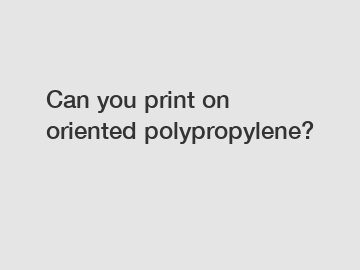Can you print on oriented polypropylene?
Can You Print on Oriented Polypropylene?
Oriented polypropylene (OPP) is a versatile packaging material known for its durability and clarity. It is widely used in the food industry for packaging snacks, confectionery, and other perishable products. However, one common question that arises is whether it is possible to print on oriented polypropylene. In this article, we will explore this question and discuss the possibilities and challenges of printing on OPP.
1. Understanding the nature of oriented polypropylene:

- Oriented polypropylene is a thin and flexible film made from polypropylene resin.
- It is produced through a process called biaxial orientation, which imparts excellent tensile strength and clarity to the material.
- OPP is usually used in its plain form without any printing, as it already offers excellent product visibility.
2. Printing techniques for oriented polypropylene:
- Standard printing techniques like offset lithography and gravure printing are not suitable for printing on OPP due to its low surface energy.
- However, it is possible to print on OPP using specialized methods such as flexographic printing and screen printing.
- Flexographic printing is a popular technique that uses flexible relief plates and fast-drying inks to print on OPP films.
- Screen printing, on the other hand, involves the use of a mesh screen to transfer ink onto the OPP surface.
3. Considerations when printing on oriented polypropylene:
- Surface treatment: Before printing on OPP, the surface needs to be treated to improve ink adhesion. This can be done through various methods like corona treatment, flame treatment, or application of primers.
- Color reproduction: OPP's clarity can affect color vibrancy and accuracy. It is important to consider this when choosing inks and designing the artwork.
- Ink compatibility: Not all inks are compatible with OPP. UV-curable and solvent-based inks are commonly used for printing on OPP due to their ability to adhere to the material and withstand handling and environmental factors.
- Testing and prototyping: It is recommended to perform test prints and prototypes to ensure desired print quality and ink adhesion before conducting large-scale printing.
4. Challenges of printing on oriented polypropylene:
- Adhesion and durability: The low surface energy of OPP can make ink adhesion challenging. Adequate surface treatment and using compatible inks are crucial for ensuring good adhesion and durability.
- Cost considerations: Specialized printing techniques and inks required for printing on OPP can be costlier compared to conventional printing methods.
- Design limitations: Due to the clear nature of OPP, opaque elements or background colors may be required to enhance the visibility of the printed artwork.
In conclusion, while it is possible to print on oriented polypropylene, it requires specialized printing techniques, surface treatment, and compatible inks. Flexographic printing and screen printing are commonly used methods for printing on OPP films. However, it is important to consider the challenges associated with ink adhesion and color reproduction. Nonetheless, with the right approach and careful consideration of the material's characteristics, printing on oriented polypropylene can result in visually appealing packaging and promotional materials extensively used in the food industry and beyond.
Contact us to discuss your requirements of metalized pet film, silicone release film, metallized bopp film. Our experienced sales team can help you identify the options that best suit your needs.



Comments
0